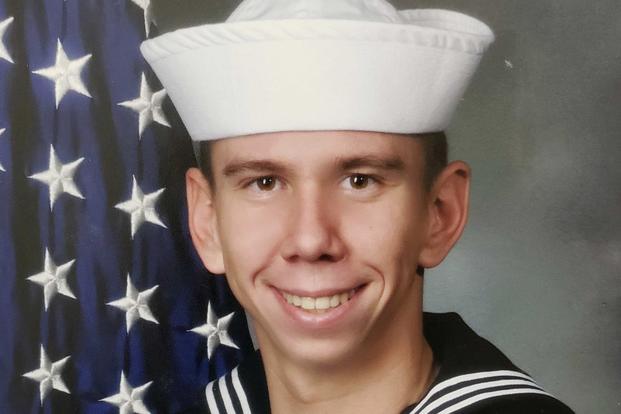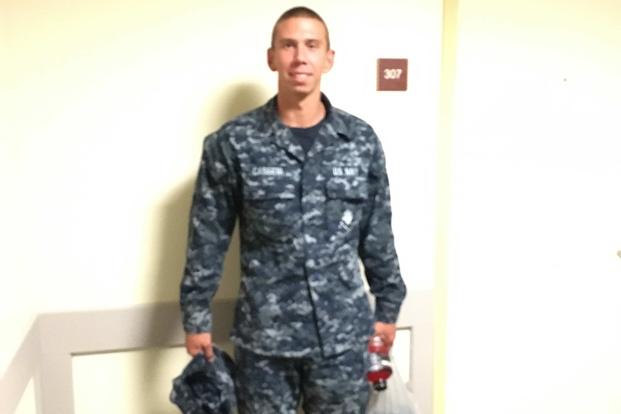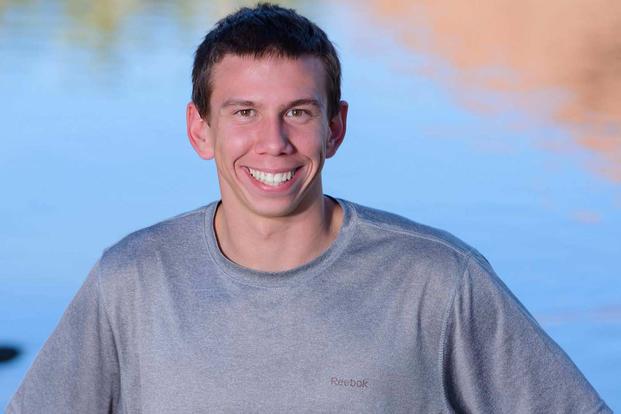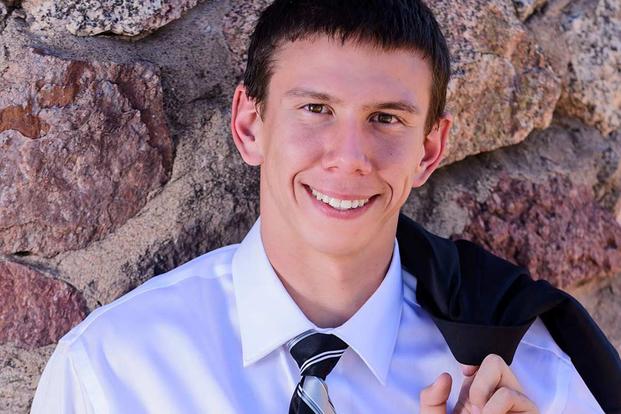Editor's Note: This article contains a description of suicide. If you or someone you know needs help, the Veterans Crisis Hotline is staffed 24 hours a day, seven days a week, at 800-273-8255, press 1. Services also are available online at www.veteranscrisisline.net or by text, 838255.
In the weeks leading up to Brandon Caserta's death, friends said little seemed amiss with the smiling sailor they knew from the "gedunk," or canteen, at Helicopter Sea Combat Squadron 28 out of Norfolk, Virginia.
A goofy, happy-go-lucky type, Caserta was usually the first to volunteer for "cleaning duty, aircraft wash or field day," squadron mates said. Sure, he regretted breaking a leg at Basic Underwater Demolition/SEAL School two years before, an injury that forced him to drop out of training to become a SEAL, but he was a trouper nonetheless.
"He was the kind of person that would drop whatever he was doing to help someone else. Day or night, rain or shine, he was always there," hometown friend Destini Mohn said in a Facebook post on his memorial page.
"Brandon was home for a few weeks [in May 2018] and he was happy, making plans for Christmas," said his father, Patrick Caserta, a retired Navy career counselor with 22 years of service. "He was a loving, caring, friendly kid."
But the 21-year-old aircrew aviation electrician's mate striker, or AEAN, did confide to friends via text that he was depressed about BUD/S and unhappy with his rating, which he felt forced to choose from a limited selection after leaving the SEAL training pipeline.

A Toxic Leader
Being at HSC-28 didn't help: Caserta and his colleagues worked for a lead petty officer (LPO) who berated them publicly, frequently cursed at them and called them out for the slightest infraction. He teased Caserta as a "BUD/S dud" and once intentionally dropped one of Brandon's care packages in front of him to watch the sailor's reaction.
Command leaders were aware of this abusive sailor, but they also knew Caserta wanted out of the squadron. He had applied for a transfer to the naval aircrewman rating and was accepted. But another accident happened. Caserta broke his collarbone while riding his bicycle, threatening his chance to make the move.
Because of the injury, Caserta's orders were canceled and he was sent back to selling candy and snacks for several months. And the progress he'd made in earning his professional qualifications as an aviation electrician's mate reset to zero. He'd been 72% complete.
His chiefs told him that he couldn't reapply for aircrew until he completed the qualifications, and they also handed him a new requirement: get a driver's license so he could be cycled into the duty driver schedule and operate vehicles on the flight line.
Except that Brandon Caserta didn't drive. He had never owned a car, didn't have insurance and, while he had taken a driving course as a teen, had never been on the road by himself. In fact, his parents Patrick and Teri said he had a phobia and hadn't been behind the wheel since taking a driver's course. He only went to the Department of Motor Vehicles to get a license so he would have a state ID and could legally drive in an emergency.
Like many young people, Caserta relied on Uber, friends and his bicycle to get around.
But HSC-28 was having none of it. The chiefs conducted a search of the Arizona Department of Motor Vehicles website and found that Caserta had once held a valid driver's license. They directed him to fork over $12 for a duplicate copy and told him they were sending him to a disciplinary review board for hiding the fact that he had a license.
He would drive the command's 18-person passenger van and no longer inconvenience any other sailors by requesting transportation to and from medical appointments for his re-rate application, according to several command counseling sheets.
"You have not performed your required duties as a watchstander (duty driver) like your peers and superiors since your assignment to HSC-28 due to the fact that you stated you are not a licensed driver. ... Recommend Disciplinary Review Board," stated his counseling record from June 22, 2018.
For Caserta, though, facing a year or more under a toxic LPO in a rating he hated, getting behind the wheel of a vehicle and enduring a disciplinary board appeared to be too much.
On June 25, 2018, Caserta left notes to several friends and his parents, walked out on the flight line at Naval Station Norfolk and hurled himself into the spinning tail rotor of an MH-60S helicopter.
"I'm sorry you have to see this," he shouted to the plane captain before he died.
Warning Signs
The decision to take one's own life is deeply personal, one made for reasons the dead often take to the grave with them. But in his suicide note, Caserta faulted the Navy, asking his parents to "go after the re-rate process" that put him in a job he hated, and expose what he saw as a flawed command.
"I want to see as many people fired, kicked out or, at the very least, lose rank," he wrote.
Related content:
- The Warning Signs of Suicide and What to Do
- Former MCPON Bawled Out Staff, Made Sailors Fetch Coffee
The words could easily be attributed to a sailor angry at the system, unhappy with himself and frustrated with life. Indeed, the command investigation concluded that Caserta was "suffering from a number of stressors, including a feeling of worthlessness since he had dropped on request from Special Warfare training and dissatisfaction with the Navy."
But the investigation found something else: a leadership problem in HSC-28 that started with Caserta's lead petty officer.
"[The lead petty officer]'s noted belligerence, vulgarity and brash leadership was likely a significant contributing factor in AEAN Caserta's decision to end his own life," the investigation states.
The investigator found "sufficient evidence to take [the LPO] to captain's mast for violation of UCMJ Article 93, Cruelty and Maltreatment" regarding Caserta. But the investigating officer then recommended against mast, instead suggesting the aviation electrician's mate 1st class, or AE1, be transferred with a "declining" evaluation.
"I do not recommend [mast] due to the fact that the member can refuse captain's mast enduring to a special or general courts-martial, further extending the timeline and exacerbating the healing process for all effected [sic] personnel," the investigating officer wrote.
The lead petty officer remains in the Navy, never having received punitive action. Military.com is not naming him as he has not been charged.
Cmdr. David Hecht, the public affairs officer for Naval Air Force Atlantic, said the LPO was placed in a leadership position after his dismissal from another supervisory role because the Navy believes in leadership opportunities and second chances.
"When he returned from detachment, he was counseled on leadership techniques, ways to improve his demeanor with junior sailors and given another opportunity to lead," Hecht said.
Institutional Problems
For the most part, this strategy appears to work. But the Navy has had its share of what are considered "toxic leaders," notably even with the service's top enlisted leader, Master Chief Petty Officer of the Navy Stephen Giordano, who retired in 2018 after an investigation found he publicly berated and humiliated his staff and treated aides like servants.
And toxic leadership, some experts say, can have a deleterious effect on those considering suicide. The Navy's suicide rate in 2018 was the highest it's ever been.
While post-mortem analyses of suicides usually show that the victim faced major issues -- financial or relationship problems, medical issues, mental health conditions -- leaders can and do play a substantial role, according to research conducted by Dave Matsuda, an anthropologist at California State University-East Bay who studied a suicide cluster among soldiers in Iraq in 2010.
Asked by the Army to "think outside the box" in studying the deaths, Matsuda found that, given the opportunity, some noncommissioned officers and officers in the chain of command make their subordinates' lives a living hell. These "toxic leaders," Matsuda concluded, can contribute to suicide decisions.
While the bad leaders weren't wholly responsible for the suicides, they did help push the soldiers over the edge, he said.
"If someone is getting smoked, it doesn't make sense to keep that leader, that commander. They are part of the problem," Matsuda said. "But, you know, all too often the military in these cases just interviews the circle of command, not the circle of trust. And the command isn't going to admit there is a problem.
"It's a bit like the Catholic Church and the sex abuse scandal," he added. "Just shuffle the toxic leaders off to another place."

Anger Management
The tirades of Caserta's LPO were well known in the command. He had been counseled while serving as a detachment LPO for "intolerable and unprofessional" behavior toward subordinates, and later relieved when his behavior didn't change.
Back at the squadron, he was sent to anger management classes and reassigned as LPO over Brandon and other junior sailors under a new chief petty officer "as a leadership challenge."
Unit chiefs were to visit the LPO’s shop more frequently, "engage the sailors and attempt to ensure they had a means to convey any concerns if things weren't working out," according to the command investigation.
Hecht told Military.com that the lead petty officer was placed back in charge of junior sailors because "the bedrock of Navy culture is the continued leadership development of both our junior and senior sailors."
"HSC-28 took actions to mentor the AE1 and help him improve his demeanor ... and give another opportunity to lead," Hecht said.
But Brandon's father, and other sailors in the command, say the decision was made by a callous leadership cadre interested only in making mission and achieving the next rank.
The command, Patrick Caserta asserts, was "so hostile, corruptive and unethical," they tormented Brandon and drove him past the brink of despair. He uses the term "murder" to describe what they did to his son.
"They killed him," he told Military.com. "We are so angry at them for not looking out for Brandon and the other troops."
"When they talk about suicide," Patrick Caserta added, referring to the command and the Pentagon as a whole, "they talk about trauma, exposure to war and mental health. But they don't talk about harassment, bullying. They just don't want to say that it happens and they are at fault."
Aviation Machinist's Mate 2nd Class (AW) Justin MacMillan, who spent nearly four years at HSC-28, said a crisis could have been foreseen. MacMillan served with Caserta and reached out to the family after Brandon's death, hoping to provide them some solace and affirmation.
"The climate [at the unit] was just go, go, go, do, do, do, we'll worry about any personal stuff later," MacMillan said. "When I checked out of the command, I told them that if they kept treating people this way, they are going to have something really bad happen."
Hecht said that after the lead petty officer's initial counseling, "no concerns meriting his removal from his position were ever brought to the awareness of HSC-28's leadership."
But an anonymous message sent to squadron commander Cmdr. Duane Whitmer on June 18, 2018, showed the abuse hadn't stopped. According to the unsigned message provided by both Patrick Caserta and included in the command investigation, the LPO called subordinates his "bitches" and referred to the chiefs behind their backs as "douchebags" and "dumbasses." He "treated his workers worse than garbage" and "like dogs."
The LPO eventually was transferred on June 28, 2018, three days after Caserta's death, and only after he was heard making "derogatory and inflammatory comments concerning the deceased."
Yet the move, according to his counseling record, was "not punitive," and "was going to happen anyway due to all the detachments that are underway to mitigate our manpower shortfalls," the record noted.
A Troubling Trend
Caserta's death was one of 68 Navy suicides in 2018. It was the worst year for suicides since the service began tracking them closely after Sept. 11, 2001. Caserta's was one of three in Norfolk-based helicopter squadrons in the first half of the year alone.
While military service was once considered a protective measure against suicide, military suicide rates have risen steadily in the years since 9/11, both among those who have deployed and those who have never deployed. The rise mirrors an increase in suicides among the general U.S. population, and suicide experts are struggling to understand why.
Those at risk include people between the ages of 15 to 24 and those over age 60. Other factors include having spent time in prison or jail, having a mental health disorder or a substance abuse problem, family violence or history of suicide, and having guns in the home, according to the Centers for Disease Control and Prevention.
MacMillan and other sailors said the stress in the command was exacerbated by the high operational tempo. The concerns they describe are similar to the stress and readiness issues determined to be a factor in the deadly collisions of the guided missile destroyers Fitzgerald and John S. McCain.
"They are working like 14 aircraft with the manning of five," MacMillan said. "They aren't leading anymore. They're dragging people along just trying to complete mission and chase their next rank."
Hecht said manning issues did not play a role in any of the command's decisions. He did not provide data regarding the unit's manning requirements or its current staffing.
A toxic leader, according to Army Doctrine Publication 6-22, "operates with an inflated sense of self-worth and from acute self-interest," consistently using "dysfunctional behaviors to deceive, intimidate, coerce, or unfairly punish others to get what they want for themselves."
They are, the directive states, a combination of "self centered attitudes, motivations, and behaviors that have adverse effects on subordinates, the organization, and mission performance."
The Navy has had its share of documented toxic leaders in recent years, with retired Capt. Holly Graf perhaps the most notorious. As commanding officer of the cruiser Cowpens, she was relieved in 2010 for demeaning and humiliating crew members, exploding with fury and a seemingly bottomless trough of expletives in tirades aimed at subordinates.
More recently, the commanding officer of the cruiser Shiloh, Capt. Adam Aycock, who managed to complete his command tour, was found to have overseen a ship in complete dysfunction, his leadership threatening the ship's readiness by causing exhaustion, despair and suicidal thoughts among sailors, according to a report in Navy Times.
Toxic leadership has even permeated the highest ranks of the service: Giordano retired the week Caserta killed himself, following an inspector general investigation into his bullying and verbally abusive behavior toward subordinates and staff.
MacMillan said he saw similar behavior at HSC-28. Caserta's LPO often "screamed, yelled and name-called" when sailors forgot to do something or made a mistake, and he would "throw fits worse than my toddler."
And a senior chief went behind his back, calling the Bureau of Naval Personnel to prevent MacMillan from going to BUD/S.
"I called the [Enlisted Community Management Branch] to ask why I got denied, and he said, 'Your senior chief had quite a few negative things to say about you.' I never found out what senior chief said, but when he got the news, he called me in and just laughed in my face. 'You aren't going back to BUD/S, you are going on the [amphibious assault ship] Kearsarge,'" MacMillan recalled. "He literally dimed me out just to get me to man a deployment."
MacMillan finally filed a Naval Inspector General complaint against the command after another issue arose: He requested to remain at the squadron and not go out on a detachment when his wife fell ill and he needed to support her and his two girls, a toddler and an infant.
He was transferred out of HSC-28 two weeks after filing the complaint.
Another sailor who asked not to be identified out of fear of retribution simply described the climate at HSC-28 as "terrible."
"It was awful," the sailor said. "There's one lead petty officer who is pretty good. But other than her, no one is looking out for junior sailors."
Fighting for Answers
In the last weeks of Caserta's life, his parents became so concerned about his welfare that his father called the command, hoping to speak with the command master chief. Instead, he reached Caserta's maintenance master chief, who told him that "people in the squadron had to do two deployments because [Caserta] didn't have his quals."
Patrick Caserta says this statement means the command never had any intention of allowing his son to transfer ratings.
"They were trying to just keep him in the command and force him ... to deploy," he said.

Hecht said HSC-28 required Caserta to get his qualifications because in the Navy, to be recommended for any special program, including aircrew transition, "the expectation is that sailors are excelling in their current positions and meeting all the necessary requirements."
"HSC-28 wanted AEAN Caserta to be successful, and his leadership was actively engaged in helping him pursue his professional qualifications in support of his career goals," Hecht said.
Patrick Caserta seriously doubts that. "They made him work in gedunk for a year. They had no interest in his career," he said.
At the moment Brandon Caserta was making his final long walk out to the flight line, Patrick Caserta was on the phone with the command master chief, expressing concern for his son's welfare and telling him he planned to fly to Norfolk to take Brandon to base legal and the equal opportunity office to discuss his options.
Brandon died before the call ended.
The unit held a memorial service four days later; Patrick and Teri say they weren't invited. Navy policy states that the command should provide round-trip travel and allowances to family members to attend a command memorial service. Hecht said the memorial service was scheduled to allow the maximum number of unit members to attend and that the family was given "advanced notice." The family also was "provided a video of the memorial service, a piece of memorabilia signed by all the squadron members and a letter of condolence from the command," he said.
Patrick Caserta said the family was excluded out of sheer pettiness.
"The command disrespected him and they disrespected us," he said.
Desperate for answers on their son's death, the Casertas reached out to Brandon's NCOs, the friends he left gifts and notes for and those he had spoken about in texts. Eventually, the friends stopped responding. The Casertas believe the command ordered a cessation of communications; the command investigation notes that most individuals decided to limit communications because it "wasn't helping the grieving process."
A Reward for Information
It's hard to tell which version is accurate, but a text sent to Brandon's parents from a junior sailor on May 31, 2019 -- after the command learned that Military.com had made phone calls regarding the Casertas' allegations -- indicates a culture of fear at the squadron.
"We are all scared that we will get into trouble. It sucks that telling the truth will make things bad for [anyone] who speaks up," the sailor wrote.
The Casertas are so angry and distraught that they have offered a $25,000 reward to anyone who will come forward with information that "would lead to successful prosecution of individuals in their son's chain of command."
They have met with congressional staff of a dozen senators and representatives, including Sen. Tim Kaine, D-Virginia, and Sen. Kyrsten Sinema, D-Arizona, to discuss the treatment they and Brandon received, request an independent investigation and promote efforts to prevent suicide linked to toxic leadership.
They also would like to see the Navy implement Brandon Caserta's request in his suicide note regarding the re-rate process: that sailors who don't complete the training for the rate they initially sought be able to select any other training they qualify for with their Armed Services Vocational Battery Test results.
Matsuda, the anthropologist, said that to truly address the problem of suicide in the armed forces, the services should consider toxic leadership when analyzing individual deaths. Operational leaders, he said, should not rely on "the boot camp strategy of breaking people down to build them back up."
"There's no proof that strategy works," Matsuda said. "And in some cases, people who are ridden hard can't take it. Toxic command climate can most certainly trigger suicidal behavior."
Whitmer, the commanding officer of HSC-28 at the time of Caserta's suicide, completed his command tour last month and has moved on. Former executive officer Cmdr. Trevor Prouty is the squadron's new CO. Command Master Chief David Tokarski remains with the squadron. One chief petty officer with the unit was promoted to ensign after Caserta's death and another is on terminal leave. The LPO remains at a unit in Norfolk.
Caserta's parents have taken their grievances public, publishing an essay earlier this week on militarycorruption.com. The Navy, they say, should find the toxic leadership of the LPO, and the subsequent failure of the command to stop the harassment of Caserta and other sailors, reprehensible.
"Make no mistake, HSC-28 murdered our son Brandon. Senior officials of HSC-28 bear the ultimate responsibility for their failures such as the decision to keep AE1 in charge. They all turned a blind eye to [his] bullying and hatred toward Brandon and others," they wrote.
-- Patricia Kime can be reached at Patricia.Kime@Military.com. Follow her on Twitter at @patriciakime.














